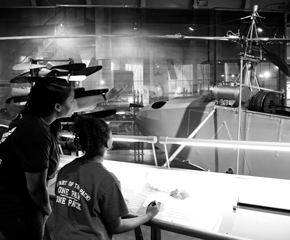Molding the Future with Mold-A-Ramas
Visitors to The Henry Ford are likely familiar with the iconic Mold-A-Rama machines scattered throughout the museum. Loud, colorful, and with that distinctive “Mold-A-Rama” smell of warm plastic, they have spit out affordable souvenirs for thousands of guests over the years. The Henry Ford boasts 10 Mold-A-Rama machines, made more impressive when you consider only a few hundred machines were ever produced.

“Antique Automobile” Mold-A-Rama machine at Henry Ford Museum of American Innovation. / Photo by staff of The Henry Ford
Like all things at The Henry Ford, Mold-A-Rama machines are a story of classic American innovation. They were invented in the 1950s by John H. “Tike” Miller, after he sought to replace a broken figurine in his Nativity set. When he was unable to buy a single figurine from his local department store, he made his own from plaster. This would eventually lead to a business selling plaster figurines and then experiments with plastic injection molding machines. These advancements in molding machine technology would allow Miller to sell thousands of plastic figures out of his Illinois factory.

Final patent for John Miller’s plastic mold injection machine. / Courtesy of Google Patents
At the end of the 1950s Miller’s company declared bankruptcy, and Miller licensed the rights to his machine to Automatic Retailers of America Inc. ARA would go on to produce hundreds of Mold-A-Rama machines throughout the 1960s. Mold-A-Ramas were featured at both the 1962 Seattle World’s Fair and the 1964 New York World’s Fair, and in 1966 they were installed at their first permanent location, the Brookfield Zoo (where they can still be found today!). After this, Mold-A-Ramas could be found in popular tourist destinations, restaurants, and even interstate rest stops. Experts estimate these golden years produced up to 300 unique moldsets for 200 machines.
Disaster struck soon after, when ARA elected to dissolve the Mold-A-Rama division of the business in 1968. The company cited high upkeep costs and excessive maintenance required as the reason for closure, a problem that continues today. By the 1970s, the original Mold-A-Rama Inc. had completely shut down.
When the company closed, both the Mold-A-Rama machines and operating locations were snapped up by various interested entrepreneurs. One such innovator was William A. Jones, a Michigan State graduate. Dissatisfied with his position as a corporate accountant, Jones purchased every Chicago area Mold-A-Rama machine and location from a retiring coworker in 1971. Ten years later, Jones would buy out a fellow operator to become the largest Mold-A-Rama company in the Midwest. In 2011, his company officially changed its name from The William A. Jones Co. to Mold-A-Rama Inc., marking the first time in 50 years that these machines were operated by their namesake. Today, Jones’s empire of wax spans seven locations across four states with nearly 60 machines.
Interestingly, the Mold-A-Rama machine has only one major competitor, the Mold-A-Matic. This story begins with store owner Eldin Irwin, who leased several Mold-A-Rama machines from ARA. When the company shut down production, Irwin purchased as much of the available inventory as he could and took the machines on the road. For years, he and his grandson would tour the country with the Mold-A-Ramas, visiting state fairs and carnivals. Like Jones, Irwin would expand his business dramatically in the 1980s. In this case, the Florida-based Mold-A-Matic Inc. wanted to sell their entire inventory, which Irwin acquired along with the name. Currently, the company is run by Irwin’s grandson and has 11 locations with nearly 50 Mold-A-Matic machines.

“1952 Weinermobile” Mold-A-Rama machine at Henry Ford Museum of American Innovation. / Photo by staff of The Henry Ford
In 2025, the dust has settled. While a handful of independently run Mold-A-Rama machines exist, Mold-A-Rama Inc. and Unique Souvenirs Inc. (formerly Mold-A-Matic Inc.) remain the only companies to service multiple locations. Both companies have remained in their respective families and are currently run by second- and third-generation Mold-A-Rama operators. The companies agree not to encroach on one another’s territories, and they even collaborate on occasion and share resources. This is especially necessary as the years pass and machines break down. Every Mold-A-Rama machine running today was built in the 1960s, and as time goes on, they become harder to repair—especially since their parts are out-of-production. Nearly 75 years after the Mold-A-Rama was first conceived, we are facing a future where it may fade out of existence.
Despite this, people’s love for the machines and their molds is still strong. Both Unique Souvenirs Inc. and Mold-A-Rama Inc. have websites providing information about the machines, their locations, and collectible molds. Griffin Museum of Science and Industry in Chicago recently hosted a temporary Mold-A-Rama exhibit, complete with additional machines and a rotation of retired molds. This exhibit was extended several times, and ultimately was so popular that it stayed on display for over two years.

Collection of current and retired molds at Griffin Museum of Science and Industry. / Photo by Staff of The Henry Ford

Display of a moldset and preliminary versions of the Mold-A-Rama at Griffin Museum of Science and Industry. / Image by Staff of The Henry Ford
Outside of official channels, Mold-A-Rama fans share their experiences and collections on various social media platforms. It is truly impressive to see a machine that should have been made obsolete continue to thrive so many years later.
Rachael Monroe is Project Cataloging Specialist at The Henry Ford.


Facebook Comments